Air of Authority - A History of RAF Organisation
No 411 - 420 Squadron Histories
Squadrons numbered in the 400 series were technically units of the RCAF, RAAF and RNZAF, but their members were placed under the operational control of the RAF and are usually considered to be part of the RAF's organisational structure, hence their inclusion here. Squadron Badges on this page - courtesy of 'Wing for Freedom' at www.rcaf.com.
No 411 (Grizzly Bear) Squadron
|
|
Formed at Digby on 16 June 1941 as a fighter squadron, it was equipped with Spitfires. Declared operational in August, it began to carry out offensive sweeps over the continent the following month. Throughout 1942 and 1943, it alternated between Digby and other stations in Fighter Command conducting the usual round of offensive sweeps and defensive patrols along the East Coast. In July 1943, the squadron became part of No126 Airfield of the 2nd Tactical Air Force and now lived under canvas. In October the squadron moved to Biggin Hill, where it re-equipped with Spitfire IXs and continued its offensive operations. In April 1944 the squadron converted to the fighter-bomber role, although it did not lose its ability to operate in the pure fighter role. It covered the D-Day landing on 6 June and on the 18th it moved over to France, moving bases as required to keep up with the advancing Allied armies. With the war over the squadron remained in Germany as part of the occupation forces, disbanding at Utersen on 21 March 1946. Motto: Inimicus Inimico (Hostile to the enemy) |
| Battle Honours |
| Defence of Britain 1941-44, English Channel and North Sea 1942-43, Fortress Europe 1941-44, Dieppe France and Germany 1944-45, Arnhem Normandy 1944 Rhine |
Squadron Codes used: -
| DB | Jun 1941 - Jul 1945 |
[Aircraft & Markings | Commanding Officers]
For details of this squadron's post war service - click here
|
|
Formed at Digby on 30 June 1941 as a fighter squadron, it was equipped with Spitfires, being declared operational in August. It was then involved in the usual round round of defensive patrols from 12 Group stations alternating with moves into 11 Group to carry out offensive sweeps over the continent. In January 1943 it moved into 9 Group and carried routine patrols and participated in Army exercise in preparation for D-Day. In July it joined No 126 Airfield (later No 126 Wing) of 2nd Tactical Air Force and in November re-equipped with Spitfire IXs. In January 1944 the squadron began training in the fighter-bomber role and resumed operations in April attacking a V-1 launching site. Having provided cover for the Normandy landings, the squadron moved to France on 18 June and began following the advance of the Allied armies as they pushed through France, the Low Countries and into Germany. Remaining in Germany as part of the occupation forces the squadron disbanded at Utersen on 21 March 1946. Motto: Promptus ad vindictum (Swift to avenge) |
| Battle Honours |
| Defence of Britain 1941-44, Fortress Europe 1941-44, Deippe English Channel and North Sea 1942-43, Arnhem Normandy 1944 Rhine |
Squadron Codes used: -
| VZ | Jun 1941 - Mar 1946 |
[Aircraft & Markings | Commanding Officers]
For details of this squadron's post war service - click here
|
|
Formed on 1 July 1941 at Stranraer, it was equipped with Catalinas, beginning operations on 7 October. It became involved in convoy escort duties and anti-submarine patrols over the North Atlantic and along the Norwegian coastline. In March 1942 the squadron personnel began the move to Ceylon, arriving at Koggala in April. Equipped again with Catalinas, the squadron immediately began patrols and became involved in combating a Japanese invasion force. The squadron continued throughout 1942 and 1943 carrying out anti-submarine patrols, convoy escorts and ASR sorties as well as operating a detachment in Aden and flying an occasional reconnaissance patrol to Sumatra, a return trip of 2,000 miles. 1944 proved to be an extremely busy year but by the end of it the squadron experienced a reduction in workload as the Japanese pulled back from the area. As a result the squadron was stood down in January 1945 and sent back to the UK to re-equip. However, this never happened and the squadron disbanded on 23 February at Bournemoth. Motto: Ad vigilamus undis (We watch the waves) |
| Battle Honours |
| Atlantic 1941-1943, Ceylon 1942, Eastern Waters 1942-1944 |
Squadron Codes used: -
| QL | Jul 1941 - Jan 1942 |
[Aircraft & Markings | Commanding Officers]
For details of this squadron's post war service - click here
No 414 (Sarnia Imperials) Squadron
|
|
Formed on 12 August 1941 at Croydon in the Army Co-operation role, it was equipped Lysanders and Tomahawks. The squadron occupied itself with exercises and training with the Army during this early period of its career. In June 1942 it began to re-equip with the Mustang I and these were taken into action during the Dieppe landings of 19 August 1942. It then began to carry out Rhubarbs and Populars over Northern France and The Channel, also undertaking convoy escort and coastal protection duties. By early 1944, it was flying Tactical and Photo Reconnaissance missions and on D-Day it spotted for the naval guns. In August it re-equipped with Spitfire IXs and moved to the continent, from where it continued to support the Allied armies as they advanced towards Germany. It continued in this role up to the end of the war and disbanded at Luneburg on 7 August 1945. Motto: Totis Viribis (With all our might) |
| Battle Honours |
| Defence of Britain 1941-43, Fortress Europe 1942-44,France and Germany 1944-45, Dieppe Normandy 1944, Arnhem, Biscay 1943 |
Squadron Codes used: -
| RU | Aug 1941 - early 1943 |
[Aircraft & Markings | Commanding Officers]
For details of this squadron's post war service - click here
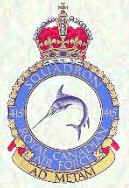 |
Formed on 20 August 1941 at Thorney Island in the torpedo bomber role. Initially equipped with Beauforts and Blenheim Is the squadron commenced training but in January 1942 before becoming operational, it exchanged both types for Hampdens, with which it carried out its first operation on 27 April. During 1942 it moved to North Coates (June), Wick (August), Leuchars (September) and back to Thorney Island (November) as well as operating a number of detachments whilst based at these locations. In 1943 it moved over to night operations as the Hampden was becoming outclassed as a torpedo bomber, but still losses increased. Therefore in September the squadron converted to Wellington XIIIs and Fairey Albacores, the former being used to locate and illuminate E-boats whilst the latter attacked them. These operations were carried out along the French and Dutch coasts and attacks were also carried out against shipping and in conjunction with Beaufighter units. On D-Day the squadron laid a smoke screen for Allied naval forces but the following month it handed its aircraft over to No 119 Squadron. No 415 then moved north to East Moor in Yorkshire, where it joined No 6 (RCAF) Group and re-equipped with Halifax IIIs. It operated as a heavy bomber unit for the remainder of the war, disbanding on 15 May 1945. Motto: Ad metum (To the mark) |
| Battle Honours |
| Atlantic 1942, English Channel & North Sea 1942 - 1945, France & Germany 1944 - 1945, Ruhr 1944 - 1945, Rhine German Ports 1944 - 1945, Normandy 1944, Biscay 1942 - 1943 |
Squadron Codes used: -
| GX | Aug 1941 - Oct 1943 |
| NH | Oct 1943 - Jul 1944 |
| 6U | Jul 1944 - May 1945 |
[Aircraft & Markings | Commanding Officers]
For details of this squadron's post war service - click here
No 416 (City of Oshawa) Squadron
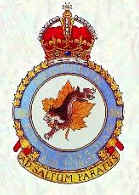 |
Formed at Peterhead on 18 November 1941, the squadron soon received Spitfires and began working up, which was completed in February 1942, when it started convoy patrols and defensive duties. It moved south in June 1942 and covered the Dieppe landings in August. It then alternated between offensive operations as part of 11 Group and defensive duties in 12 Group, until July 1943 when it joined No 127 Airfield (later 127 Wing) at Kenley It now provided cover for the numerous bombing missions being carried out against targets in Northern France as well as covering the landings themselves. On 16 June 1944 the squadron moved to the beachhead and from then until VE-Day followed the advancing Allied armies through France, the Low Countries and into Germany. Remaining part of the British Air Forces of Occupation, the squadron re-equipped with Spitfire XIVs in September 1945 but disbanded on 19 March 1946 at Utersen. Motto: Ad saltum paratus (Ready for the leap) |
| Battle Honours |
| Defence of Britain 1942-44, Arnhem Fortress Europe 1942-44, English Channel and North Sea 1943, Dieppe Normandy Rhine France and Germany 1944-45, Gulf War 1991 |
Squadron Codes used: -
| DN | Nov 1941 - Mar 1946 |
[Aircraft & Markings | Commanding Officers]
For details of this squadron's post war service - click here
No 417 (City of Windsor) Squadron
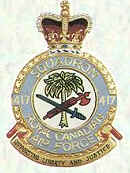 |
Formed at Charmy Down on 27 November 1941, the squadron soon received Spitfires and began working up and was called to readiness on 12 February 1942, as part of Operation Fuller, the attempt to stop the Gneisenau and Scharnhorst sailing up The Channel. Later that month it moved to Tain in Scotland, but in March it was withdrawn from operations in preparation of a move overseas. Arriving in Egypt in June 1942 after a trip around the Cape, the pilots where initially attached to the Aircraft Delivery Unit, whilst the ground personnel serviced US Bombers in the Area. The squadron re-assembled on 6 September 1942, equipped with Hurricanes and immediately began defensive duties in the Canal Zone. In October, Spitfire began to arrive and by February 1943, it was fully equipped. It used these to carry out offensive patrols in support of the 8th Army advancing west and following the Allied victory in north Africa, the squadron moved to Luqa in Malta in July. From here it covered the invasion of Sicily, moving to the island itself on 13 July. It was now able to support the invasion of Italy, to where it moved in September. Following the Anzio landings, the squadron flew high level cover to the re-supply convoys. In June it returned to the 8th Army area of operations and continued to provide both fighter and close air support to the ground forces as they advanced northwards until the end of the war. It was disbanded at Treviso on 1 July 1945 Motto: Supporting Liberty and Justice |
| Battle Honours |
| Defence of Britain 1942, Egypt and Libya 1942-43, North Africa 1943, Sicily 1943, Italy 1943-45 Salerno Anzio and Nettuno Gustav Line Gothic Line |
Squadron Codes used: -
| AN | Nov 1941 - Jul 1945 |
[Aircraft & Markings | Commanding Officers]
For details of this squadron's post war service - click here
No 418 (City of Edmonton) Squadron
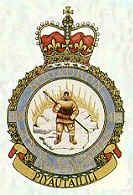 |
Formed at Debden on 15 November 1941 in the night intruder role, equipped with Bostons. However, work up was slow and it was March 1942 before the squadron was declared operational, flying its first mission on the 26th. As well as the standard Boston, it also used examples armed with a solid nose mounting 20mm cannons, which it used to devastating effect. In May 1943, the squadron converted to Mosquito VIs and on 15 September 1943 it acted in the escort fighter role to a force of Lancasters from No 617 Squadron attacking the Dortmund-Elms Canal. In 1944 the squadron began to operate in daylight and on 2 May it claimed its 100th victim. In August the squadron began night operations against V-1 flying bombs and in September began strikes against V-2 launching sites. On 21 November 1944 the squadron was transferred from No 11 Group, Fighter Command to No 2 Group, 2nd Tactical Air Force as a light bomber squadron. It continued in this role until the end of the war, disbanding at Volkel on 7 September 1945. Motto: Piyautailili (Defend even unto death) |
| Battle Honours |
| Defence of Britain 1944, Fortress Europe 1942-44, France and Germany 1944-45, Normandy 1944 Rhine |
Squadron Codes used: -
| TH | Nov 1941 - Sep 1945 |
[Aircraft & Markings | Commanding Officers]
For details of this squadron's post war service - click here
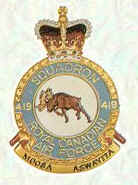 |
Formed at Mildenhall on 15 December 1941 as part of No 3 Group, it was the third RCAF bomber unit to formed in this country. It initially operated Wellington IC and III aircraft and having moved north to Leeming and then Topcliffe in August 1942 to join No 4 Group, it moved again in September to Croft and once again in November to Middleton St George. It now settled here and in the same month converted to Halifax II heavy bombers. In January 1943 the squadron transferred to the newly created No 6 (RCAF) Groupand continued to operate as part of bomber Command's Main Force for the remainder of the war, converting to Lancasters in March 1944. One of its members, Plt Off Andrew Mynarski was awarded a posthumous Victoria Cross for his actions in freeing the rear gunner of their burning Lancaster on the night of 12 June 1944. The squadron returned to Canada in June 1945 and disbanded on 5 September 1945. Motto: Moosa aswayita |
| Battle Honours |
| English Channel and North Sea 1942-1944, Normandy 1944, Rhine Baltic 1942-1944, Fortress Europe 1942-1944, Biscay 1942-1944, France and Germany 1944-1945, Biscay Ports 1942-1945, Ruhr 1942-1945, Berlin 1943-1944, German Ports 1942-1945 |
Squadron Codes used: -
| VR | Dec 1942 - Sep 1945 |
Aircraft & Markings | Commanding Officers[
For details of this squadron's post war service - click here
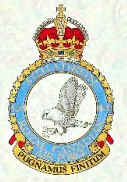 |
Formed at Waddington on 19 December 1941 as the fourth RCAF bomber unit in Bomber Command. As a 5 group unit it was equipped with Hampdens, carrying out its first operation on the night of 21/22 January 1942. In August 1942 the squadron transferred to No 4 Group and moved to Skipton on Swale in Yorkshire, at the same time exchanging its Hampdens for Wellingtons. In in October it moved again, this time to Middleton St George and on 1 January 1943 it joined the newly formed No 6 (RCAF) Group. However, in May the squadron was posted to North Africa and for three months operated as part of No 205 Group attacking targets in Sicily and Italy. Returning to No 6 Group in November, its new home was Dalton, but a month later it settled at Tholthorpe, at the same time converting to the Halifax III, remaining until the end of the war. In April 1945 it received Canadian built Lancaster Xs and in June it flew home to Canada, where it disbanded on the 16th. Motto: Pugnamus finitum (We fight to a finish) |
|
|
|
Photograph of Flt Lt Les Rush's crew - April 1945 (supplied by Ben May - far right) |
| Battle Honours |
| Defence of Britain 1944, Fortress Europe 1942-1944, France and Germany 1944-1945, Normandy 1944 |
Squadron Codes used: -
| PT | Dec 1941 - Sep 1945 |
[Aircraft & Markings | Commanding Officers]
For details of this squadron's post war service - click here
This page was last updated on 17/03/25©
![]() Organisational Index
Organisational Index ![]()